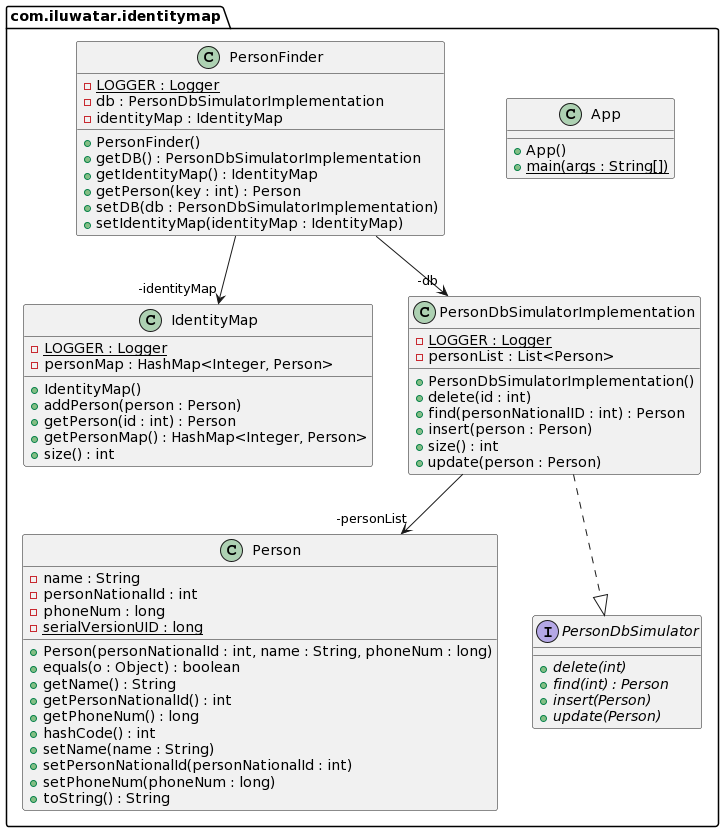Identity Map
- Behavioral
Intent
Ensures that each object gets loaded only once by keeping every loaded object in a map. Looks up objects using the map when referring to them.
Explanation
Real world example
We are writing a program which the user may use to find the records of a given person in a database.
In plain words
Construct an Identity map which stores the records of recently searched for items in the database. When we look for the same record next time load it from the map do not go to the database.
Wikipedia says
In the design of DBMS, the identity map pattern is a database access design pattern used to improve performance by providing a context-specific, in-memory cache to prevent duplicate retrieval of the same object data from the database
Programmatic Example
- For the purpose of this demonstration assume we have already created a database instance db.
- Let's first look at the implementation of a person entity, and it's fields:
@EqualsAndHashCode(onlyExplicitlyIncluded = true)
@Getter
@Setter
@AllArgsConstructor
public final class Person implements Serializable {
private static final long serialVersionUID = 1L;
@EqualsAndHashCode.Include
private int personNationalId;
private String name;
private long phoneNum;
@Override
public String toString() {
return "Person ID is : " + personNationalId + " ; Person Name is : " + name + " ; Phone Number is :" + phoneNum;
}
}
- The following is the implementation of the personFinder which is the entity that the user will utilize in order to search for a record in our database. It has the relevant DB attached to it. It also maintains an IdentityMap to store the recently read records.
@Slf4j
@Getter
@Setter
public class PersonFinder {
private static final long serialVersionUID = 1L;
// Access to the Identity Map
private IdentityMap identityMap = new IdentityMap();
private PersonDbSimulatorImplementation db = new PersonDbSimulatorImplementation();
/**
* get person corresponding to input ID.
*
* @param key : personNationalId to look for.
*/
public Person getPerson(int key) {
// Try to find person in the identity map
Person person = this.identityMap.getPerson(key);
if (person != null) {
LOGGER.info("Person found in the Map");
return person;
} else {
// Try to find person in the database
person = this.db.find(key);
if (person != null) {
this.identityMap.addPerson(person);
LOGGER.info("Person found in DB.");
return person;
}
LOGGER.info("Person with this ID does not exist.");
return null;
}
}
}
- The identity map field in the above class is simply an abstraction of a hashMap with personNationalId as the keys and the corresponding person object as the value. Here is its implementation:
@Slf4j
@Getter
public class IdentityMap {
private Map<Integer, Person> personMap = new HashMap<>();
/**
* Add person to the map.
*/
public void addPerson(Person person) {
if (!personMap.containsKey(person.getPersonNationalId())) {
personMap.put(person.getPersonNationalId(), person);
} else { // Ensure that addPerson does not update a record. This situation will never arise in our implementation. Added only for testing purposes.
LOGGER.info("Key already in Map");
}
}
/**
* Get Person with given id.
*
* @param id : personNationalId as requested by user.
*/
public Person getPerson(int id) {
Person person = personMap.get(id);
if (person == null) {
LOGGER.info("ID not in Map.");
}
return person;
}
/**
* Get the size of the map.
*/
public int size() {
if (personMap == null) {
return 0;
}
return personMap.size();
}
}
- Now we should construct a dummy person for demonstration purposes and put that person in our database.
Person person1 = new Person(1, "John", 27304159);
db.insert(person1);
- Now let's create a person finder object and look for person with personNationalId = 1(assume that the personFinder object already has the db and an IdentityMap attached to it.):
PersonFinder finder = new PersonFinder();
finder.getPerson(1);
- At this stage this record will be loaded from the database and the output would be:
ID not in Map.
Person ID is:1;Person Name is:John;Phone Number is:27304159
Person found in DB.
- However, the next we search for this record again we will find it in the map hence we will not need to go to the database.
Person ID is:1;Person Name is:John;Phone Number is:27304159
Person found in Map.
- If the corresponding record is not in the DB at all then an Exception is thrown. Here is its implementation.
public class IdNotFoundException extends RuntimeException {
public IdNotFoundException(final String message) {
super(message);
}
}
Class diagram

Applicability
- The idea behind the Identity Map pattern is that every time we read a record from the database, we first check the Identity Map to see if the record has already been retrieved. This allows us to simply return a new reference to the in-memory record rather than creating a new object, maintaining referential integrity.
- A secondary benefit to the Identity Map is that, since it acts as a cache, it reduces the number of database calls needed to retrieve objects, which yields a performance enhancement.